1921 – 1958
During the early 1910s the most established shipping companies were Britain’s Cunard and White Star lines and Germany’s H.A.P.A.G. and Norddeutscher Lloyd lines. The battle of the North Atlantic vessels stood between fantastic ships such as Olympic, Mauretania, Imperator and Kronprinzessin Cecilie. Even though White Star had received a major stroke in 1912, when the Titanic sunk, the company still ranked as one of the most powerful. But, in spite of that these companies operated some services other than on the North Atlantic, the trans-Atlantic trade was the most interesting in this friendly war between some of Europe’s states.
One British company that aimed somewhere else than on the North Atlantic was the Union-Castle Mail Steamship Company Limited, or as it was more commonly known as – the Union-Castle Line. The main route for them was between Britain and South Africa. In 1910 two handsome liners were commissioned for this service – the 6,000-tonners Balmoral Castle and Edinburgh Castle. Still, these liners had nothing to compete with when it came to the prestigious ships on the North Atlantic service. With this in mind the management of the Union-Castle Line commissioned two new liners to be built in 1915. This was during raging war and it would take several years before any of these ships saw completion.
The intended name for the vessels in this new duo was Amroth Castle and Windsor Castle. During the slow construction the name was considered to be changed for the first vessel, and when she was launched on September 11, 1919, her name had been changed to Arundel Castle. Her builders had been the distinguished ship building company Harland and Wolff in Belfast, Ireland. As she was laid down as number 455, she was the 54th vessel built by them since the ill-fated but beautiful Titanic.
The Arundel Castle’s maiden voyage took place on April 22, 1921, and had Cape Town, South Africa as final destination. The ship was truly a remarkable sight. She was the first vessel in the world since the Aquitania to sport a quartet of funnels. This perhaps seemed a bit outdated, but when the ship was laid down in 1915 the design was not quite that old. This was also something Union-Castle had wanted in order to resemble the larger, North Atlantic liners. The master of the Arundel Castle’s first voyage was Captain T. J. Bremner R.N.R. He commanded a ship that had left other ships on the route entirely behind. The passenger accommodation was something spectacular for such a ship. Every cabin at any rate had a new sort of air condition installed, so no one had to rely on the old blowing fan any longer. Also, you could enjoy a nice afternoon in the indoor swimming pool, or spend it in the ship’s gymnasium. Just like her North Atlantic ideals, she sported an electric lift to take passengers between the decks. The safety facilities were also something that people talked about. Once again, the Titanic comes in mind when noticing that just abaft her fourth funnel there were two giant davits in all handling twelve lifeboats. Added to this specific pile, the rest of the ship also seemed packed with lifeboats, even on the poop deck. As everyone knows, safety on the high seas had turned into something far beyond perfection since the 1912-disaster.
When the Arundel Castle’s premier voyage almost had come to an end, and she had reached the South African port of East London she suddenly encountered bad weather and she was unable to load or discharge at this stop. This later resulted in that this port was abandoned by Union-Castle, and the not-to-far-away port of Algoa Bay was used instead.
The Union-Castle served as a link between Britain and her colony South Africa, and since the Arundel Castle and her sister Windsor Castle were the prime ships in its fleet, they often had to be the actual link. In September 1923, Arundel Castle carried General Smuts and members of his South African Cabinet to the Imperial Conference in London. The general is said to have enjoyed the voyage immensely. Later in her inaugural year, one of the ship’s seamen accidentally fell overboard. The passengers put together the then enormous sum of £350 for his poor dependants back on shore. In December the same year, two stowaways were discovered when some of the ship’s crew was about to lower one of the lifeboats in order to recover a person who had fallen overboard. What a rotten bit of luck!
In 1924, an enormous floating dry dock had been constructed to be able to handle the gigantic trio of ship Albert Ballin once had designed in the early 1910s – Imperator, Vaterland and Bismarck. Now, these vessels were known as Berengaria, Leviathan and Majestic, and the dry dock was large enough to accommodate the largest of the ships – the 56,000-ton, 955-feet long Majestic who was the largest ship in the world. The dock was able to take up to 60,000 tons and had a length of 960 feet. However, the first ship to use this dock was neither of Ballin’s trio, but the 19,000-ton Union-Castle steamer Arundel Castle. She sailed into it on June 27, 1924, and the use of the dock was proved to be excellent, even to smaller vessels.
On an outward voyage from Southampton in November 1926, the Arundel Castle suffered a collision with the 1,400-ton coaster Maud Llewellyn. Neither of the ships were severely damaged, but still the Arundel Castle appeared as a ‘Lloyd’s Casualty’.
Both Arundel Castle and her sister ship Windsor Castle sailed on as profitable vessels through the 1920s and well into the 1930s. However, in the mid-Thirties, Union-Castle felt they had to update their fleet in some way. As all of the grand four stackers were about to go to the scrap yards, and the four-funnelled Union-Castle liners were too young for that, something had to be done with them. Plans emerged how to completely change the profiles of the ships in order to make them more up-to-date. Many were the Union-Castle ships that went to Harland and Wolff in late 1936, but two of them came back into service with an entirely new appearance. The famous Arundel Castle with sister had had their four distinguished funnels removed and replaced with only two, thicker ones. The bows of the ships had been given a rake so that the ships emerged 25 feet longer than before. This new exterior was praised worldwide, and it has been said more than once that these two ships became the most beautiful on the seas. The appearance was not the only thing Harland and Wolff changed. After too many years as coal-burners, they were finally converted to oil instead. This proved to increase the service speed by over three knots. The entire conversion had taken nine months, and in September 1937, the Arundel Castle was back in service.
During the Second World War, the Arundel Castle served as a transport mainly in Mediterranean waters. Sadly, the Windsor Castle was lost in March 1943, but Arundel Castle went through the war unharmed. At the end of the hostilities, the Arundel Castle made some voyages under diplomatic protection when she took British troops home from German soil via Sweden. She also assisted in bringing her country mates home from France, when she sailed between Marseille and Liverpool.
When the war finally was over, the Arundel Castle was not immediately converted back to her peace time passenger service. She kept her troop accommodation, and used it for South African emigrant berths, still under government supervision. In late 1949, the ship was sent back to her builders for a much needed refit, and in September of 1950 she finally returned to company service – the last ship in the Union-Castle fleet to be handed back.
Eight years later, the Arundel Castle made her 200th voyage on April 12, 1957. But the end was drawing near. On December 5, 1958, she made her 211th and final voyage from Cape Town. She had steamed for 3,475,565 miles altogether, of which 600,000 had been during war time. In early 1959, Hong Kong ship breakers bought her and she commenced her absolutely final voyage – to Chiap Hua Manufactory Company Limited. The elegant Harland and Wolff-built ship was no more.
Specifications
- 661 feet (201.9 m) long, lengthened to 686 feet (209.5 m) during 1937 refit
- 72 feet (22 m) wide
- 18,980 gross tons
- Steam turbines powering two propellers
- 17 knot service speed, increased to 20 knots after 1937 refit
- Passenger capacity of 1,170 people

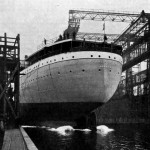
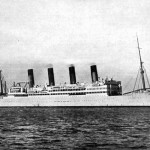
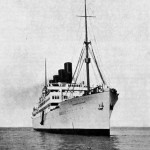
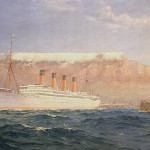
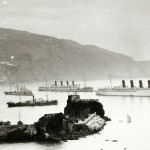
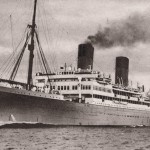
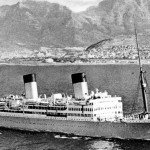
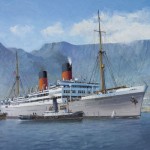
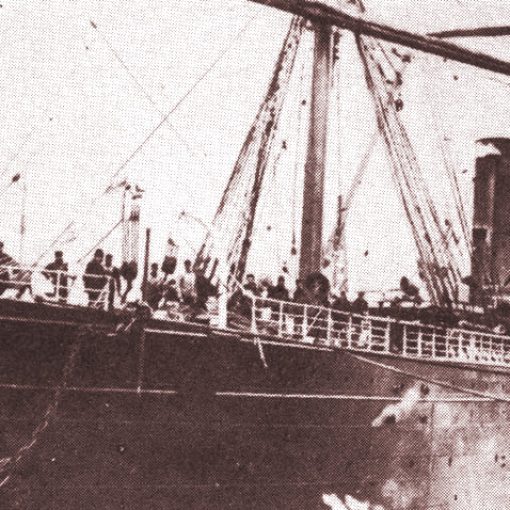


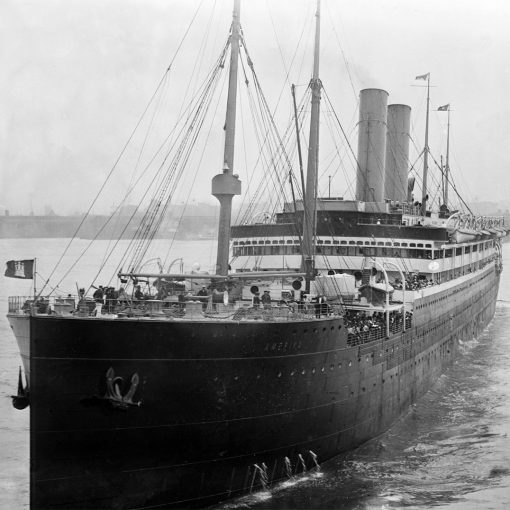
3 thoughts on “Arundel Castle (II)”
My grandfather was the ship’s printer for Union Castle Line between Southampton and Cape Town but I don’t know which vessel. It would have been mid 1920s. Anyone know how I may be able to find out? Would any archives have lists of crew/workers on board?
Congratulations on the new look site. I come originally from Cape Town and remember the Arundel Castle well. It may be of interest to you that the reason for the upgrade of several Union Castle ships in the 1930s was not that the company felt they looked outdated. Their mail contract came up for renewal and the new contract cut the time allowed for the voyage by a day or two. Old ships like the Edinburgh Castle which hadn’t a hope of meeting the new timetable were scrapped. Two new ships were ordered and the rest of the fleet upgraded. It must have cost Union Castle a lot but the mail contract was their lifeblood.
Thank you, Peter, for your kind words on the new website! Thank you also for pointing out the business-end reason for the updated design of the Arundel Castle and her sister. You are correct in that it doesn’t come across very well in our article, but aesthetics was far from the top priority behind the decision, just as you wrote. When mulling over photos of grand interiors, it is easy to forget that these ships were mail carriers as well, which earned their companies a steady stream of income.